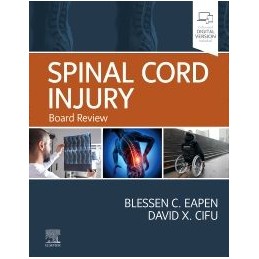- Obniżka


 Dostawa
Dostawa
Wybierz Paczkomat Inpost, Orlen Paczkę, DHL, DPD, Pocztę, email (dla ebooków). Kliknij po więcej
 Płatność
Płatność
Zapłać szybkim przelewem, kartą płatniczą lub za pobraniem. Kliknij po więcej szczegółów
 Zwroty
Zwroty
Jeżeli jesteś konsumentem możesz zwrócić towar w ciągu 14 dni*. Kliknij po więcej szczegółów
Opis
Table of Contents - to be finalised
Questions included with each chapter
Chapter 1: Introduction to the Spinal Cord Injury Boards
Chapter 2: Epidemiology, Risk Factors, and Prevention of SCI
Chapter 3: Anatomy and Imaging of the Spinal Cord
Chapter 4: Assessment, Classification and Prognosis of Spinal Cord Injury
Chapter 5: Acute Evaluation and Management of Spinal Cord Injury
Chapter 6: Cardiovascular Issues in Spinal Cord Injury
Chapter 7: Pulmonary Issues in Spinal Cord Injury
Chapter 8: Gastrointestinal Issues in Spinal Cord Injury
Chapter 9: Genitourinary Issues in Spinal Cord Injury
Chapter 10: Sexual and Reproductive Health in Spinal Cord Injury
Chapter 11: Musculoskeletal Issues in Spinal Cord Injury
Chapter 12: Neurological Complications of Spinal Cord Injury
Chapter 13: Pressure Injuries
Chapter 14: Pain in Spinal Cord Injury
Chapter 15: Nutrition, Endocrine and Immune Function in Spinal Cord Injury
Chapter 16: Psychological Disorders in Spinal Cord Injury
Chapter 17: Rehabilitation in Spinal Cord Injury
Includes functional assessment, exercise and modalities (therapeutic exercise, functional estim, modalities, non-traditional therapies), mobility (gait, ambulation/lower extremity orthoses, wheelchairs/other mobility devices, transfers, positioning, and sitting balance), ADLs (adaptive equipment/functional orthosis, architectural adaptations, tendon transfers, environmental control technology), and speech and communication
Chapter 18: Miscellaneous Topics in Spinal Cord Injury
Includes participation/living with SCI (recreation and sports, community access and driving, vocational rehabilitation, social issues), healthcare systems (rehabilitation team, patient safety, medico-legal issues, advocacy, practice management), clinical and basic science (research and statistical methods, neural injury/regeneration), spinal orthosis, ethics and professionalism, and electrodiagnostic assessment.
